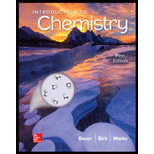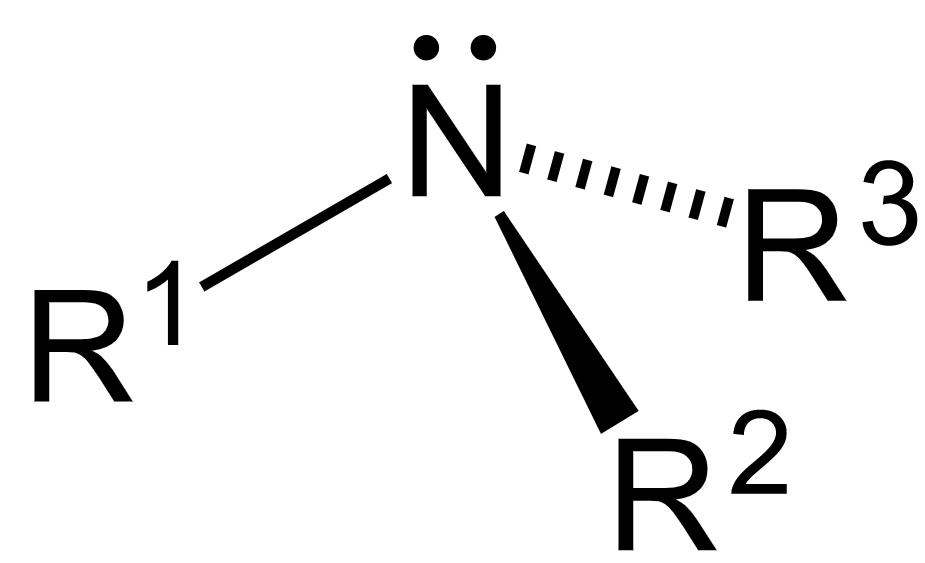
INTRODUCTION TO CHEMISTRY(LL)-W/CONNECT
5th Edition
ISBN: 9781260264920
Author: BAUER
Publisher: MCG
expand_more
expand_more
format_list_bulleted
Concept explainers
Question
Chapter 16, Problem 97QP
Interpretation Introduction
Interpretation:
The given equation for the reaction of an amine with hydrochloric acid is to be completed.
Concept Introduction:
The general structure of an amine is as follows:

It has a nitrogen atom with a lone pair of electrons and three substituents. The amines act as bases due to the presence of an unshared electron pair on the nitrogen atom.
Expert Solution & Answer
Want to see the full answer?
Check out a sample textbook solution
Students have asked these similar questions
How a Carboxylic Acid and an Amine Undergo an Acid–Base Reaction?
Which statements are true about amines?
NH3+ is the form found in our blood
amines can react with aldehydes to produce ethers
amines act as weak acids in aqueous solutions
amines can react with carboxylic acid to produce alcohols
Which functional groups are present in the following structure?
Chapter 16 Solutions
INTRODUCTION TO CHEMISTRY(LL)-W/CONNECT
Ch. 16 - Prob. 1QCCh. 16 - Prob. 2QCCh. 16 - Prob. 3QCCh. 16 - What are cyclic hydrocarbons, and how do they...Ch. 16 - Prob. 5QCCh. 16 - Prob. 6QCCh. 16 - Prob. 7QCCh. 16 - Prob. 8QCCh. 16 - Prob. 9QCCh. 16 - Prob. 1PP
Ch. 16 - Prob. 2PPCh. 16 - Prob. 3PPCh. 16 - Prob. 4PPCh. 16 - Prob. 5PPCh. 16 - Prob. 6PPCh. 16 - Prob. 7PPCh. 16 - Prob. 8PPCh. 16 - Prob. 9PPCh. 16 - Prob. 10PPCh. 16 - Prob. 11PPCh. 16 - Prob. 1QPCh. 16 - Prob. 2QPCh. 16 - Prob. 3QPCh. 16 - Prob. 4QPCh. 16 - Prob. 5QPCh. 16 - Prob. 6QPCh. 16 - Prob. 7QPCh. 16 - Prob. 8QPCh. 16 - Prob. 9QPCh. 16 - Prob. 10QPCh. 16 - Prob. 11QPCh. 16 - Prob. 12QPCh. 16 - Prob. 13QPCh. 16 - Prob. 14QPCh. 16 - Prob. 15QPCh. 16 - Prob. 16QPCh. 16 - Prob. 17QPCh. 16 - Prob. 18QPCh. 16 - Prob. 19QPCh. 16 - Prob. 20QPCh. 16 - Prob. 21QPCh. 16 - Prob. 22QPCh. 16 - Prob. 23QPCh. 16 - Prob. 24QPCh. 16 - Prob. 25QPCh. 16 - Prob. 26QPCh. 16 - Prob. 27QPCh. 16 - Prob. 28QPCh. 16 - Prob. 29QPCh. 16 - Prob. 30QPCh. 16 - Prob. 31QPCh. 16 - Prob. 32QPCh. 16 - Prob. 33QPCh. 16 - Prob. 34QPCh. 16 - Prob. 35QPCh. 16 - Prob. 36QPCh. 16 - Prob. 37QPCh. 16 - Prob. 38QPCh. 16 - Prob. 39QPCh. 16 - Prob. 40QPCh. 16 - Prob. 41QPCh. 16 - Write IUPAC names for the following compounds....Ch. 16 - Prob. 43QPCh. 16 - Prob. 44QPCh. 16 - Prob. 45QPCh. 16 - Prob. 46QPCh. 16 - Prob. 47QPCh. 16 - Prob. 48QPCh. 16 - Prob. 49QPCh. 16 - Prob. 50QPCh. 16 - Prob. 51QPCh. 16 - Prob. 52QPCh. 16 - Prob. 53QPCh. 16 - Prob. 54QPCh. 16 - Prob. 55QPCh. 16 - Prob. 56QPCh. 16 - Prob. 57QPCh. 16 - Prob. 58QPCh. 16 - Prob. 59QPCh. 16 - Prob. 60QPCh. 16 - Prob. 61QPCh. 16 - Prob. 62QPCh. 16 - Prob. 63QPCh. 16 - Prob. 64QPCh. 16 - Prob. 65QPCh. 16 - Prob. 66QPCh. 16 - Prob. 67QPCh. 16 - Prob. 68QPCh. 16 - Prob. 69QPCh. 16 - Prob. 70QPCh. 16 - Prob. 71QPCh. 16 - Prob. 72QPCh. 16 - Prob. 73QPCh. 16 - Prob. 74QPCh. 16 - Prob. 75QPCh. 16 - Prob. 76QPCh. 16 - Prob. 77QPCh. 16 - Prob. 78QPCh. 16 - Prob. 79QPCh. 16 - Prob. 80QPCh. 16 - Prob. 81QPCh. 16 - Prob. 82QPCh. 16 - Prob. 83QPCh. 16 - Prob. 84QPCh. 16 - Prob. 85QPCh. 16 - Prob. 86QPCh. 16 - Prob. 87QPCh. 16 - Prob. 88QPCh. 16 - Predict and explain the relative boiling points of...Ch. 16 - Prob. 90QPCh. 16 - Prob. 91QPCh. 16 - Prob. 92QPCh. 16 - Prob. 93QPCh. 16 - Prob. 94QPCh. 16 - Prob. 95QPCh. 16 - Prob. 96QPCh. 16 - Prob. 97QPCh. 16 - Prob. 98QPCh. 16 - Prob. 99QPCh. 16 - Prob. 100QPCh. 16 - Prob. 101QPCh. 16 - Prob. 102QPCh. 16 - Prob. 103QPCh. 16 - Prob. 104QPCh. 16 - Prob. 105QPCh. 16 - Prob. 106QPCh. 16 - Prob. 107QPCh. 16 - Prob. 108QPCh. 16 - Prob. 109QPCh. 16 - Prob. 110QPCh. 16 - Prob. 111QPCh. 16 - Prob. 112QPCh. 16 - Prob. 113QPCh. 16 - Prob. 114QPCh. 16 - Prob. 115QPCh. 16 - Prob. 116QPCh. 16 - Prob. 117QPCh. 16 - Prob. 118QPCh. 16 - Prob. 119QPCh. 16 - Prob. 120QPCh. 16 - Prob. 121QPCh. 16 - Draw the line structures for the ether and two...Ch. 16 - Prob. 123QPCh. 16 - Prob. 124QPCh. 16 - Prob. 125QPCh. 16 - Prob. 126QPCh. 16 - Write structural formulas for all the isomers of...Ch. 16 - Prob. 128QPCh. 16 - Prob. 129QPCh. 16 - Prob. 130QPCh. 16 - Prob. 131QPCh. 16 - Prob. 132QPCh. 16 - Prob. 133QPCh. 16 - Prob. 134QPCh. 16 - Prob. 135QPCh. 16 - Prob. 136QPCh. 16 - Prob. 137QPCh. 16 - Prob. 138QPCh. 16 - Prob. 139QPCh. 16 - Prob. 140QPCh. 16 - Prob. 141QPCh. 16 - Prob. 142QPCh. 16 - Prob. 143QP
Knowledge Booster
Learn more about
Need a deep-dive on the concept behind this application? Look no further. Learn more about this topic, chemistry and related others by exploring similar questions and additional content below.Similar questions
- what is the difference between an amine and an amide?arrow_forwardWhich of the following examples are acid derivatives? A ) Amines B ) amides C ) ester D ) aldehydes E ) acyl chloridearrow_forwardWrite both condensed and line structures for (a) the ester formed when butyric acid reacts with cyclopentanol, (b) the amide formed when isopropyl amine is reacted with butyric acid, and (c) the amide formed when diethylamine is reacted with butyric acid.arrow_forward
- Draw the structures of the following compounds: N-ethyl-N-methylhexan-3-aminearrow_forwardIdentify the characteristics of carboxylic acids, esters, and amidesarrow_forwardMany substitution reactions are initiated by electrostatic attraction between reactants. Show where this attraction arises in the formation of an amide from an amine and an ester.arrow_forward
- Draw the structure of a molecule of one diamine and one diacyl chloride reacting with each other, clearly showing the amide bond. HCI is also produced by this reaction. decanedioyl chloride CIarrow_forwardWrite the structure of prop-2-en-l-amine.arrow_forwardAspirin has the following structure, what are the names of the functional groups present? OH CH3 amide alcohol ether ester ketone aldehyde phenol carboxylic acidarrow_forward
arrow_back_ios
SEE MORE QUESTIONS
arrow_forward_ios
Recommended textbooks for you
- Chemistry: Matter and ChangeChemistryISBN:9780078746376Author:Dinah Zike, Laurel Dingrando, Nicholas Hainen, Cheryl WistromPublisher:Glencoe/McGraw-Hill School Pub Co
 Chemistry for Today: General, Organic, and Bioche...ChemistryISBN:9781305960060Author:Spencer L. Seager, Michael R. Slabaugh, Maren S. HansenPublisher:Cengage Learning
Chemistry for Today: General, Organic, and Bioche...ChemistryISBN:9781305960060Author:Spencer L. Seager, Michael R. Slabaugh, Maren S. HansenPublisher:Cengage Learning Chemistry & Chemical ReactivityChemistryISBN:9781337399074Author:John C. Kotz, Paul M. Treichel, John Townsend, David TreichelPublisher:Cengage Learning
Chemistry & Chemical ReactivityChemistryISBN:9781337399074Author:John C. Kotz, Paul M. Treichel, John Townsend, David TreichelPublisher:Cengage Learning  Chemistry & Chemical ReactivityChemistryISBN:9781133949640Author:John C. Kotz, Paul M. Treichel, John Townsend, David TreichelPublisher:Cengage Learning
Chemistry & Chemical ReactivityChemistryISBN:9781133949640Author:John C. Kotz, Paul M. Treichel, John Townsend, David TreichelPublisher:Cengage Learning World of Chemistry, 3rd editionChemistryISBN:9781133109655Author:Steven S. Zumdahl, Susan L. Zumdahl, Donald J. DeCostePublisher:Brooks / Cole / Cengage Learning
World of Chemistry, 3rd editionChemistryISBN:9781133109655Author:Steven S. Zumdahl, Susan L. Zumdahl, Donald J. DeCostePublisher:Brooks / Cole / Cengage Learning General, Organic, and Biological ChemistryChemistryISBN:9781285853918Author:H. Stephen StokerPublisher:Cengage Learning
General, Organic, and Biological ChemistryChemistryISBN:9781285853918Author:H. Stephen StokerPublisher:Cengage Learning

Chemistry: Matter and Change
Chemistry
ISBN:9780078746376
Author:Dinah Zike, Laurel Dingrando, Nicholas Hainen, Cheryl Wistrom
Publisher:Glencoe/McGraw-Hill School Pub Co

Chemistry for Today: General, Organic, and Bioche...
Chemistry
ISBN:9781305960060
Author:Spencer L. Seager, Michael R. Slabaugh, Maren S. Hansen
Publisher:Cengage Learning

Chemistry & Chemical Reactivity
Chemistry
ISBN:9781337399074
Author:John C. Kotz, Paul M. Treichel, John Townsend, David Treichel
Publisher:Cengage Learning

Chemistry & Chemical Reactivity
Chemistry
ISBN:9781133949640
Author:John C. Kotz, Paul M. Treichel, John Townsend, David Treichel
Publisher:Cengage Learning

World of Chemistry, 3rd edition
Chemistry
ISBN:9781133109655
Author:Steven S. Zumdahl, Susan L. Zumdahl, Donald J. DeCoste
Publisher:Brooks / Cole / Cengage Learning

General, Organic, and Biological Chemistry
Chemistry
ISBN:9781285853918
Author:H. Stephen Stoker
Publisher:Cengage Learning